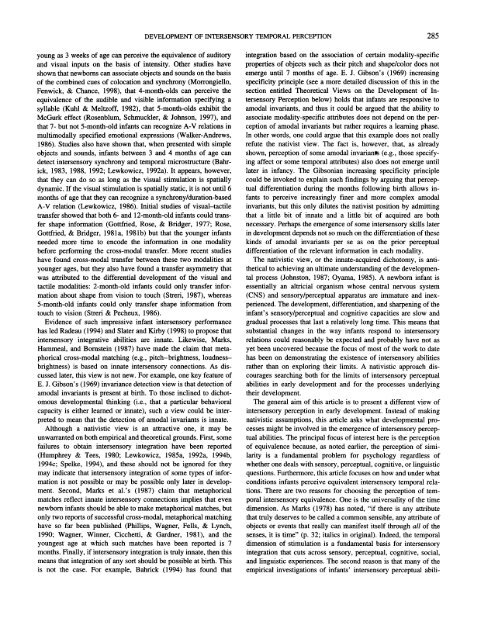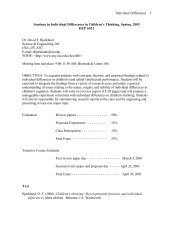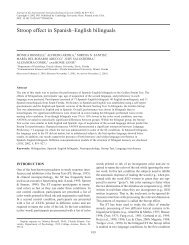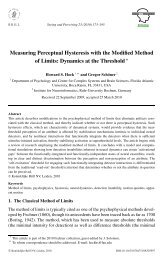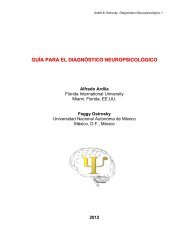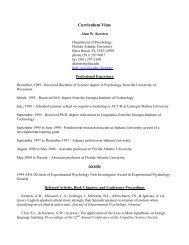The Development of Intersensory Temporal Perception: An ...
The Development of Intersensory Temporal Perception: An ...
The Development of Intersensory Temporal Perception: An ...
Create successful ePaper yourself
Turn your PDF publications into a flip-book with our unique Google optimized e-Paper software.
DEVELOPMENT OF INTERSENSORY TEMPORAL PERCEPTION 285young as 3 weeks <strong>of</strong> age can perceive the equivalence <strong>of</strong> auditoryand visual inputs on the basis <strong>of</strong> intensity. Other studies haveshown that newborns can associate objects and sounds on the basis<strong>of</strong> the combined cues <strong>of</strong> colocation and synchrony (Morrongiello,Fenwick, & Chance, 1998), that 4-month-olds can perceive theequivalence <strong>of</strong> the audible and visible information specifying asyllable (Kuhl & Meltz<strong>of</strong>f, 1982), that 5-month-olds exhibit theMcGurk effect (Rosenblum, Schmuclder, & Johnson, 1997), andthat 7- but not 5-month-old infants can recognize A-V relations inmultimodally specified emotional expressions (Walker-<strong>An</strong>drews,1986). Studies also have shown that, when presented with simpleobjects and sounds, infants between 3 and 4 months <strong>of</strong> age candetect intersensory synchrony and temporal microstructure (Bahrick,1983, 1988, 1992; Lewkowicz, 1992a). It appears, however,that they can do so as long as the visual stimulation is spatiallydynamic. If the visual stimulation is spatially static, it is not until 6months <strong>of</strong> age that they can recognize a synchrony/duration-basedA-V relation (Lewkowicz, 1986). Initial studies <strong>of</strong> visual-tactiletransfer showed that both 6- and 12-month-old infants could transfershape information (Gottfried, Rose, & Bridger, 1977; Rose,Gotffried, & Bridger, 1981a, 1981b) but that the younger infantsneeded more time to encode the information in one modalitybefore performing the cross-modal transfer. More recent studieshave found cross-modal transfer between these two modalities atyounger ages, but they also have found a transfer asymmetry thatwas attributed to the differential development <strong>of</strong> the visual andtactile modalities: 2-month-old infants could only transfer informationabout shape from vision to touch (Streri, 1987), whereas5-month-old infants could only transfer shape information fromtouch to vision (Streri & Pecheux, 1986).Evidence <strong>of</strong> such impressive infant intersensory performancehas led Radeau (1994) and Slater and Kirby (1998) to propose thatintersensory integrative abilities are innate. Likewise, Marks,Hammeal, and Bornstein (1987) have made the claim that metaphoricalcross-modal matching (e.g., pitch-brightness, loudnessbrightness)is based on innate intersensory connections. As discussedlater, this view is not new. For example, one key feature <strong>of</strong>E. J. Gibson's (1969) invariance detection view is that detection <strong>of</strong>amodal invariants is present at birth. To those inclined to dichotomousdevelopmental thinking (i.e., that a particular behavioralcapacity is either learned or innate), such a view could be interpretedto mean that the detection <strong>of</strong> amodal invariants is innate.Although a nativistic view is an attractive one, it may beunwarranted on both empirical and theoretical grounds. First, somefailures to obtain intersensory integration have been reported(Humphrey & Tees, 1980; Lewkowicz, 1985a, 1992a, 1994b,1994c; Spelke, 1994), and these should not be ignored for theymay indicate that intersensory integration <strong>of</strong> some types <strong>of</strong> informationis not possible or may be possible only later in development.Second, Marks et al.'s (1987) claim that metaphoricalmatches reflect innate intersensory connections implies that evennewborn infants should be able to make metaphorical matches, butonly two reports <strong>of</strong> successful cross-modal, metaphorical matchinghave so far been published (Phillips, Wagner, Fells, & Lynch,1990; Wagner, Winner, Cicchetti, & Gardner, 1981), and theyoungest age at which such matches have been reported is 7months. Finally, if intersensory integration is truly innate, then thismeans that integration <strong>of</strong> any sort should be possible at birth. Thisis not the case. For example, Bahrick (1994) has found thatintegration based on the association <strong>of</strong> certain modality-specificproperties <strong>of</strong> objects such as their pitch and shape/color does notemerge until 7 months <strong>of</strong> age. E. J. Gibson's (1969) increasingspecificity principle (see a more detailed discussion <strong>of</strong> this in thesection entitled <strong>The</strong>oretical Views on the <strong>Development</strong> <strong>of</strong> <strong>Intersensory</strong><strong>Perception</strong> below) holds that infants are responsive toamodai invariants, and thus it could be argued that the ability toassociate morality-specific attributes does not depend on the perception<strong>of</strong> amodal invariants but rather requires a learning phase.In other words, one could argue that this example does not reallyrefute the nativist view. <strong>The</strong> fact is, however, that, as alreadyshown, perception <strong>of</strong> some amoral invarian~ (e.g., those specifyingaffect or some temporal attributes) also does not emerge untillater in infancy. <strong>The</strong> Gibsonian increasing specificity principlecould be invoked to explain such findings by arguing that perceptualdifferentiation during the months following birth allows infantsto perceive increasingly finer and more complex amodalinvariants, but this only dilutes the nativist position by admittingthat a little bit <strong>of</strong> innate and a little bit <strong>of</strong> acquired are bothnecessary. Perhaps the emergence <strong>of</strong> some intersensory skills laterin development depends not so much on the differentiation <strong>of</strong> thesekinds <strong>of</strong> amodal invariants per se as on the prior perceptualdifferentiation <strong>of</strong> the relevant information in each morality.<strong>The</strong> nativistic view, or the innate-acquired dichotomy, is antitheticalto achieving an ultimate understanding <strong>of</strong> the developmentalprocess (Johnston, 1987; Oyama, 1985). A newborn infant isessentially an altricial organism whose central nervous system(CNS) and sensory/perceptual apparatus are immature and inexperienced.<strong>The</strong> development, differentiation, and sharpening <strong>of</strong> theinfant's sensory/perceptual and cognitive capacities are slow andgradual processes that last a relatively long time. This means thatsubstantial changes in the way infants respond to intersensoryrelations could reasonably be expected and probably have not asyet been uncovered because the focus <strong>of</strong> most <strong>of</strong> the work to datehas been on demonstrating the existence <strong>of</strong> intersensory abilitiesrather than on exploring their limits. A nativistic approach discouragessearching both for the limits <strong>of</strong> intersensory perceptualabilities in early development and for the processes underlyingtheir development.<strong>The</strong> general aim <strong>of</strong> this article is to present a different view <strong>of</strong>intersensory perception in early development. Instead <strong>of</strong> makingnativistic assumptions, this article asks what developmental processesmight be involved in the emergence <strong>of</strong> intersensory perceptualabilities. <strong>The</strong> principal focus <strong>of</strong> interest here is the perception<strong>of</strong> equivalence because, as noted earlier, the perception <strong>of</strong> similarityis a fundamental problem for psychology regardless <strong>of</strong>whether one deals with sensory, perceptual, cognitive, or linguisticquestions. Furthermore, this article focuses on how and under whatconditions infants perceive equivalent intersensory temporal relations.<strong>The</strong>re are two reasons for choosing the perception <strong>of</strong> temporalintersensory equivalence. One is the universality <strong>of</strong> the timedimension. As Marks (1978) has noted, "if there is any attributethat truly deserves to be called a common sensible, any attribute <strong>of</strong>objects or events that really can manifest itself through all <strong>of</strong> thesenses, it is time" (p. 32; italics in original). Indeed, the temporaldimension <strong>of</strong> stimulation is a fundamental basis for intersensoryintegration that cuts across sensory, perceptual, cognitive, social,and linguistic experiences. <strong>The</strong> second reason is that many <strong>of</strong> theempirical investigations <strong>of</strong> infants' intersensory perceptual abili-


